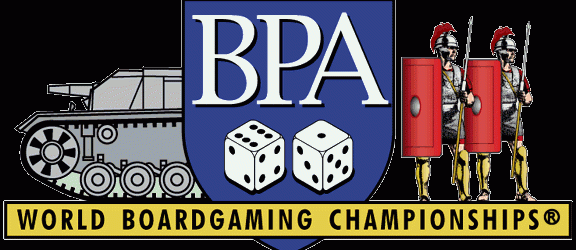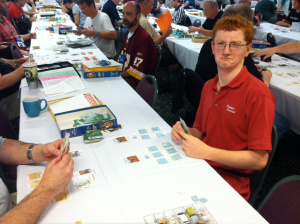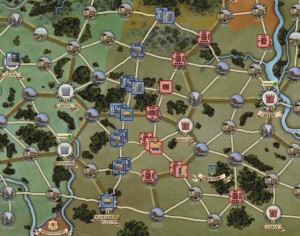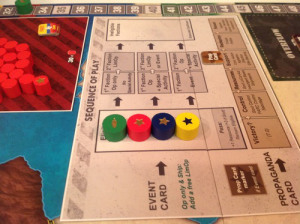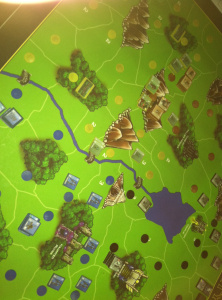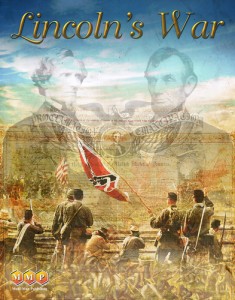By Fred W. Manzo – August 2011
WBC 2011
A few of us attended three conventions this year (2011): MonsterCon in Tempe, Arizona, Historicon in Valley Forge, Pennsylvania, and WBC in Lancaster, Pennsylvania. Origins is on the schedule for next year.
The relative size of these cons is somewhat hard to judge but we’d say there were about 250 people at MonsterCon (also known as the ConSimWorld Expo), 600 at WBC and maybe 1200+ at Historicon. WBC had two large and one medium size hall packed at all times. However, it did not have a full-time flea market and its dealer area was only a quarter the size of the one at Historicon.
But, in their own way, each was a blast!
WBC, for example, had numerous week-long tournaments, as one would expect from a convention called the “World Boardgaming Championship,” but it also had plenty of other things to do. In particular, we liked the chance to play prototype versions of the various P-500 games with their designers and to see demos of recently published games put on by their developers and play-testers.
This is not something you can do at a typical game convention. At least not in the numbers that were possible at WBC. For example, we talked to Volko Ruhnke of Labyrinth: the War of Terror, 2001-? and Andean Abyss fame, Sal Vista, the designer of the upcoming Unconditional Surrender! from GMT and Larry Bogucki, the designer of Warparty from Lock’n Load games.
Plus, we had the opportunity to pick up a copy of the eagerly awaited Space Empires SF game. At least, the pre-orders and a few extra copies were available in the dealer’s area.
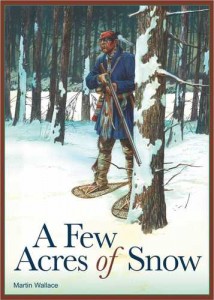 We also had a chance to examine Lincoln’s War and Proud Monster and a few of us even got to play a complete game of Warparty with one of its chief play-testers. Plus, we kibitzed over A Few Acres of Snow with expert players and discussed possible future articles for A World at War, Andean Abyss, A Few Acres of Snow and Unconditional Surrender!. So things may get hopping around.
We also had a chance to examine Lincoln’s War and Proud Monster and a few of us even got to play a complete game of Warparty with one of its chief play-testers. Plus, we kibitzed over A Few Acres of Snow with expert players and discussed possible future articles for A World at War, Andean Abyss, A Few Acres of Snow and Unconditional Surrender!. So things may get hopping around.
The four games we were most interested in seeing were:
Lincoln’s War, a P-500 game from MMP.
A Few Acres of Snow on the British and French wars for North American, published by Treefrog Games.
Warparty, a fantasy empire building game, on Lock’n Load’s P-500 list.
Andean Abyss, a 4 player political and military game on 1990’s Colombia and a P-500 game from GMT.
All are Card Driven Games (CDG).
We also played Strike of the Eagle from Academy games among ourselves. It’s funny how a bunch of guys would take the trouble to drive across multiple state lines in order to meet new people and play new games and for part of the time end up playing games we already own with people we already know. But as was pointed out, we were on vacation, so why not?
Strike of the Eagle, from designer Uwe Eickert’s Academy Games, is a card driven point-to-point block game. Let’s just say it turned out to be THE surprise of the convention. You see, we had tried it out before and hadn’t really see anything special. However, that was more our fault then the game’s. Once we gave it a second try, we were forced to revise our opinion drastically upward. It was simply the most interesting wargame our group played at the WBC.Strike of the Eagle represents the Polish – Soviet War of 1920, the “Miracle of the Vistula” war. It’s a CDG with surprising depth. Of course, each card may be put to multiple uses, which is normal enough. But there are more uses for the cards than a typical player has cards. So tense situations abound.
First, the cards may generate random events as usual, or they may generate reinforcements at a future time, or they can supplement combat strengths during any battle taking place now or lastly, they could generate additional order tokens. Needless to say, players typically wish they could use all of these options at once. In fact, how you use your cards is the key to success in this system.
Second, players start off each phase with an extremely limited number of order tokens, which represents a commanding general’s instructions to his troops. If card play is the key to this system, then the proper usage of the few tokens you get is its lock. Because without being activated by one of these orders, units may not move.
Orders also allow players to conduct reconnaissance, railroad units, March or Force March units “Here”, March or Force March units away from “Here” or re-organize a unit, that is reinforce an out-of-action unit. As these order tokens are placed face down on the map, in any order and one at a time in an IGO-YUGO manner, players have any number of opportunities to introduce a rather large Fog of War element into each game.
For example, you could issue a number of re-organization and recon orders on your left flank in the hope your opponent assumes your main push will fall there. After all, all your orders were placed on the left. So something important must be brewing. With a little luck your opponent might even be induced to waste an order force marching reserves in that direction.
Unfortunately for your ever trusting opponent, order tokens are placed on the board face down and one at a time. And, as you could have generated more orders than your opponent by burning useless event cards for their order token value, the sophisticated player could have gamed the situation by waiting until his opponent had placed his last order, before plunking down a “March Here” order on his right flank.
In other words, your opponent could have been left completely in the dark as to your intensions, even though he possessed a God’s Eye View of the battlefield. That’s not an effect most wargames can reproduce.
As for the prototype games we had come to see, Volko Ruhnke’s Andean Abyss was just remarkable.
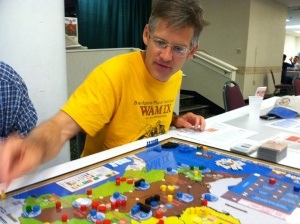
Designer Volko Ruhnke, the winner of both the 2010 Charles S. Roberts Award for Excellence in Wargame Design for the best post-World War II wargame and the James F. Dunnigan Design Elegance Award for his Labyrinth: The War on Terror, 2001 – ?.demoing Andean Abyss
If there was anyone whose could be said to have caused a stir at WBC it was designer Volko Ruhnke, the winner of both the 2010 Charles S. Roberts Award for Excellence in Wargame Design for the best post-World War II wargame and the James F. Dunnigan Design Elegance Award for his Labyrinth: The War on Terror, 2001 – ?. When those certificates were presented to him in the tournament room something like a paparazzi swarm developed.
A small swarm, maybe, but a swarm nonetheless. Perhaps a swarmette?
However, there usually were three or four people around his table at any one time anyway, as Volko was always available to answer questions and play demos. Now, I’m far from an expert at Andean Abyss, but I’d say it is the most innovative Card Driven Game I’ve ever seen. But, it might be a bit abstract for old school wargamers. So if that doesn’t faze you, I’d recommend jumping right in. Just think of it as a cross between Here I Stand and Labyrinth, part conflict simulation, part Euro.
According to Volko, Andean Abyss has about 470 pre-orders on the GMT P-500 site right now and got around 30 pre-orders last month, so he’s hoping to see it published sometime late next year.
The heart of this game is its card system, which is a bit difficult to discuss in detail, but here’s my attempt to do so…
 In Andean Abyss 4 players vie for control of 1990’s Colombia. They run the forces of the central government, the Communist guerrillas (FARC), the right wing militia (The AUC) and the drug cartels. Each has its own abilities, limitations, costs and victory conditions. Andean Abyss uses an area movement system and variously shaped blocks to represent factions, units and bases. And while there will be a winner, there will not be a player who sweeps all before him.
In Andean Abyss 4 players vie for control of 1990’s Colombia. They run the forces of the central government, the Communist guerrillas (FARC), the right wing militia (The AUC) and the drug cartels. Each has its own abilities, limitations, costs and victory conditions. Andean Abyss uses an area movement system and variously shaped blocks to represent factions, units and bases. And while there will be a winner, there will not be a player who sweeps all before him.
It works like this:
First: Each faction may perform an unlimited number of operations (or “Ops”) from their own list of possibilities or one of a number of “special activity” from another of their lists or just one of their regular operations (I.E., a “limited operation”) or they might perform either of two versions of a random event on the active card or, just possibly, they might activate various combinations of these options. Plus, of course, a faction could decide to pass this turn in order to remain eligible next turn or it might even be ineligible to do anything this turn because it did something last turn.
Second: There are two face-up cards that limit these options. The first is the active card and the second is the on-deck card. So every player gets to know, in general, what’s going on this turn and what may go on next turn. That is, which random events might be triggered. However, cards typically have two versions of these events: one pro-government and one anti-government (say, for example, “US delivers new helicopters, the government may airlift 3 extra units anywhere this turn” and “The US delays delivery of new helicopters, the government may only airlift one unit anywhere this turn”). As a result the player who triggers a particular random event is the player who decides which version to use.
Third: The symbols of the four factions are printed in a random order across the top of each event card, which is the order of play for a turn. But because this line changes from card to card, and only two cards are face up at any time, players are only aware of the order of play for this turn and the next one
Fourth: There is also an extremely important flow chart printed on the board.
Believe me, it’s not as hard as it sounds and after one or two play-throughs most people will get the hang of this system.
For example, at the beginning of the first turn all four factions are eligible to play, as obviously none of them have been activate in the prior turn. So all of their cubes would start on the left most “eligible” box of the all-important flow chart. Plus the faction whose symbol appears on the left of the order line on the active card would now decide what to do. That is, he would pick which channel through the flow chart he will use. The limiting factors are that only one faction cube may end up in most action boxes on the chart and only one channel through the chart may be used per turn. So going first can be kind of a big deal.
Now, the first or top channel through the chart contains two boxes, as do the other channels. But the first box of this particular channel only allows for the execution of regular operations by the player whose cube ends up there, while the second box in this channel allows another player to execute one of his normal operations (I.E., a Limited Op). On the other hand, the middle channel allows both the execution of normal operations plus one special activity by the player activating this channel and then permits a second player to execute either an event on the active card or one of his limited operations when his cube ends up in its second box. Finally, the bottom channel allows one version of the event to be executed by the first player and then permits another player to execute his normal operations plus one of his special activities when his cube is transferred to its second box.
Therefore, if the first activating player chooses the upper channel, the random events on the primary card simply cannot be used this turn, no matter who else is or isn’t eligible to play or what the other players wish. Believe me, this is a powerful, if temporary, advantage.
But, any player who activated his forces this turn, and so used one of the channel boxes on the flow chart, will have to move his faction cube onto the “ineligible box” at the far right side of the flow chart at the end of the turn. This means he will be shut out from using the chart through the entire next turn, and without a go-ahead from the flow chart he will also be shut out of triggering any ops, special activity or random event.
So, as Liddell Hart might say, players will find themselves “placed on the horns of a dilemma.” Should they play for a short term advantage or wait for a long term advantage to mature? After all, they may not even be eligible to trigger the future events they see coming. (That is, one of the players who activates after you this turn may also be eligible to activate his forces before you next turn. This other player could therefore decide to pass later this turn and when it becomes time to act next turn he might trigger the negative version of the upcoming event first.) So although players quickly recognize multiple options are possible, they must also realize that not all of these possibilities involve knowable factors. Just like real life.
Remember, going first may be powerful advantage this time, but depending on the developing situation, going first might be an even bigger deal next time.
As is obvious, this is a game of wheels within wheels within wheels, which allows for all sorts of temporary alliances to form quickly and to dissolve just as quickly. In our case, the cartels at one time had a base in a small southern city. There was also a sizable government garrison there and some communist rebels as well. However, the government allowed the drug base to exist because the communist were short of cash and they were using their extortion powers to generate money. If the government wiped out the drug base, it might help them in the short run but the Reds would still need money and the only other faction left in the city would then be the government. So in the government player’s mind either he paid up or the drug cartels paid up. He, therefore, decided that it was in his own long term interests to leave the cartels in peace at that location even though he was simultaneously having his air force eradicate their drug fields elsewhere. Of course, the government could have wiped out the communists in the city and stopped their extortion racket cold, but he might have had more important things to do with his limited resources or he might have wanted the Reds to attack the AUC in another part of the country. If he attacked the Communists in the city, they might not agree to attack the AUC further north. After all, it was nothing personal, it was just business. The cartels solution to this problem was to cash out their base. The cartels got some money, while the government and the rebels were left to fight it out among themselves.
Keep in mind that although each faction has a rather long list of typical operations only they can perform and their own special activities and their own victory conditions, not everything can be done at once and during some turns nothing much can be done at all. This is not a “rebels versus the government” game, but rather a 4 way asymmetrical struggle where each side is for and against each other side, even within a single turn. In effect, players are juggling 5 or 6 balls in the air simultaneously and whoever drops the fewest will win.
Designer Larry Bogucki’s board game Warparty, on the other hand, is a “4X” empire building fantasy game. Namely, players eXpand, eXplore, eXtract and eXterminate. It’s basically a 4 player game involving 2 teams consisting of various heroes, wizards and armies.
Each player starts out in a stronghold with a small army. He then sends out war parties to explore his corner of the world, including any of its haunted locations, while those who stay behind either build up his remaining “normal” forces or branch out economically, technologically and/or via wizardry, although each player’s stronghold is shaped to reflect his own unique characteristics, there being Human, Dwarf, Undead and Goblin players.
The game usually last from 2 hours for the more experienced to about 3 hours for newbies. I doubt any game could run much longer than that even though there are multiple avenues to explore. That’s because “inflation” is used as a limiting factor. Once any general grows his empire beyond a certain level all costs for ALL the players are doubled. And once any empire grows a bit more, costs are quadrupled. That being the case, players tend to expand, fight and then quickly find themselves unable to recruit enough replacements to make good their battle loses. Once you stop expanding in this game the end is near.
Lincoln’s War
Lincoln’s War, by designer John Poniske, involves not just the military side of the Civil War but the political side as well. It’s also on a P-500 list (Multiman Publishing). It involves Enthusiasm Support Points (ESP) and Immobilization Tokens (IT) in a counter based format. It’s a resource management Card Driven Game of moderate complexity.
Players represent the opposing Presidents as they struggle to get their sometimes balking generals to advance. Lincoln’s War includes a wide selection of the usual Civil War characters plus some of the more obscure ones as well, such as Fernando Wood, Clement Vallendigham and Zebulon Vance. Combat does not, however, involve the normal strength point counters or, for the most part, dice. Large armies are represented by high ranking generals, while small armies appear as low ranking general counters. As the game progresses, however, successful low ranking generals (with their corresponding small armies) may be promoted into high ranking generals (with their accompanying large armies). In addition, there are blockade and commerce raiding rules.
Think of it as A House Divided CDG with politics, although it is hex based.
Editor’s Note: John Poniske is running aLincoln’s War Strategy Contest. The contest winner gets a free copy of Lincoln’s War when published. Looks kind of interesting. I’ll be submitting my solution soon!
And as for newly published games, the one we found most interesting was:
A Few Acres of Snow, by designer Martin Wallace, is a card driven point-to-point game of the British – French struggle to control North America. Players represent either the British colonist in New England or their French counterparts in lower Canada. The regular units, militia and Native American forces are all represented by counters, while the villages, towns and fortified settlements are represented by pieces. Players may upgrade villages to towns, they may also fortify towns and they can conduct raids and sieges. In general, players expand their empires over the course of the game in order to generate a large enough force to raze their opponent’s settlements.
It’s also a kind of deck building game in that each expansion of a player’s holdings will place new cards into his active deck that could be used, in combination with cards he already has, to launch raids down the coast or perhaps across the St. Lawrence river. He could, say, play a ship card and a regulars card and a native American card to raid an enemy coastal village or start to siege an enemy fortress. Apparently, the game’s name came from the reaction of politicians back in Paris to insistent requests for ever more aid: “Why should we spend any more money defending a few acres of snow?”
Conclusion
Each convention we visited this year had its own unique feel: Historicon, for example, specialized in miniatures, which covered both historical and pulp fiction topics. MonsterCon focused on the larger games, such as Wellington’s Victory, while WBC featured multi-day tournaments, open gaming and P-500 games. It was not a matter of judging which was “better,” it was a matter of enjoying each for their unique take on our hobby. If it is at all possible, we highly recommend you take the time to attend at least one of them next year.


